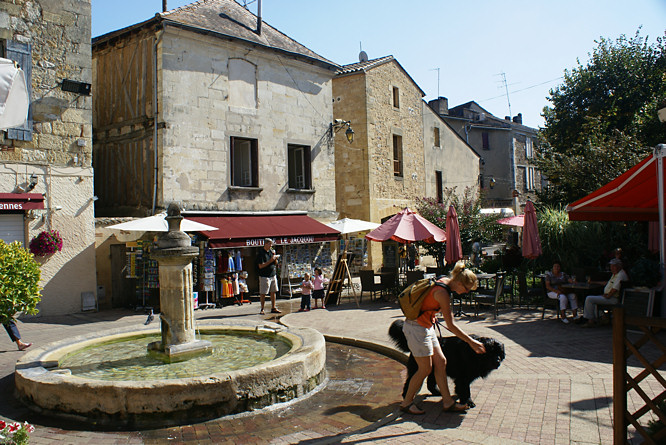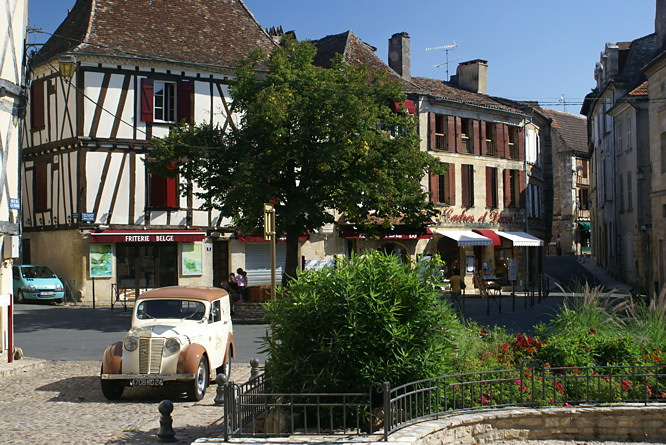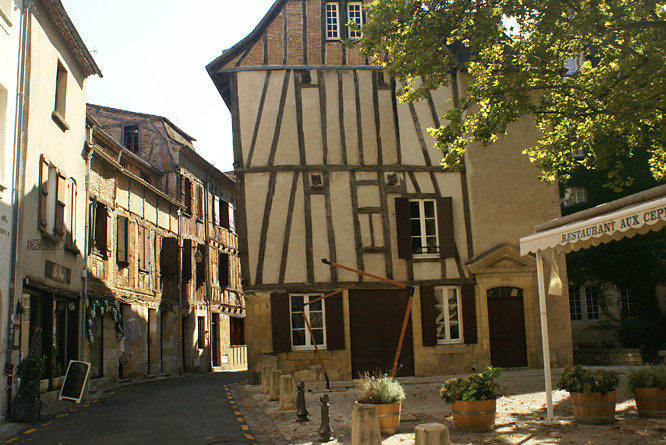Bergerac in the Dordogne
Enjoy the town. Bergerac is a lovely place filled with attractive old architecture with a couple of good museums and a number of beautiful squares in which to sit and relax. Bergerac, the second-largest town in the Dordogne with 30,000 inhabitants, is the capital of south-west Perigord and only a 15 minute drive away.

The district known as the land of the vineyard or Purple Périgord is vast in it's diversity. The history of Bergerac since the Middle Ages can be summed up in three words: the river, the wine and the bridge. Bergerac today is a town bustling with life and vitality, especially in the pedestrianised area of the old quarter, where there is an abundance of cafes, restaurants, markets, boutique and antique shops.
You will be enchanted by the richness and originality of its museums, the variety of produce and wonderful aromas of its markets, the exquisite flavours of the cuisine and wines, and the wonderful warmth and generosity of its people.
The fireworks on Bastille Day are truly memorable. In and around Bergerac the 100,000 acres of vineyards produce 75 % of Dordogne's wine production. The cellar of every wine cooperative is open for tasting, particularly the Bergerac and Monbazillac cellars which are very popular with visitors. The wines of AOC Bergerac include, Pecharmant, one of the most highly appreciated by connoisseurs. the fruity Rose, the white and red Côtes-de-Bergerac and the mellow white Montravel. To the south there is the very well known Monbazillac, and, around Sigoules, Saussignac.

Maison des Vins - Bergerac
The Maison des Vins is housed in a section of a 17th century cloister. The entryway into the cloister has wall displays that detail the history of wine in the region. You can follow the panels downstairs to a room where a short video loops (French and English versions are played). It is a short film, and has some beautiful scenes of the countryside, so it doesn't hurt to take a seat for ten minutes.
The next stage in the Maison des Vins (the whole "museum" is free), is a centre for testing your nose ~ you can play around with different stations to see how easily you identify about 25 scents (woods, fruits, etc.) that assist your wine tasting skill. The self-guided tour ends in a shop with free tastings ~ there was no pressure to buy.
Le Vieux Port - Bergerac's old port
The old port area of Bergerac is actually quite lovely. There are spots both on the quai and on the banks of the river to sit and gaze over the Dordogne. The port was the site of an 11th-century castle that protected the city ~ it was overtaken in 1615 and brought to ruins shortly thereafter. This is also the spot where 'gabare,' or traditional boat rides, leave from during the main tourist season.
Vieux Pont - Bergerac's old bridge
Vieux Pont - Bergerac In winters past, the Dordogne's level would rise high enough to submerge substantial parts of the lower town. The worst of the floods, in 1783, actually washed away the bridge that was later replaced by the one yu see today. The construction of dams has succeeded in preventing any recent floods. Today, the port is quite attractive, despite being bordered by a municipal parking lot

Aquarium du Perigord Noir - Bergerac
Both recreational and educational, this aquarium has 3000000 litres of water where in natural light you can watch 6000 plus fish. With more than 30 pools you make a voyage through 5 covered visiting areas. Outside there is a shop and a bar Croc-o-Gril" and mini golf, picnic area. toilets, access ramps for wheelchairs. Great family day out. Address Le Bugue/Vezere.
La Place Pelissiere - Pelissiere Square in Bergerac
This is the largest, and arguably the prettiest, square in Bergerac. There's a lovely fountain, a fantastic view of the Eglise Saint Jacques and some lovely patios to sit at and enjoy your surroundings. All of the streets that lead off from this square are attractive as well with some beautiful older town homes (15th and 16th century).
La Place de la Mirpe - Bergerac
Bergerac has more than it's share of attractive, pedestrianized squares. La place de la Mirpe is yet another ~ this one home to a statue of Rostand's character Cyrano de Bergerac (no real connection to the town). The square is surrounded by picturesque half-timbered houses.
L'eglise Saint Jacques - Saint Jacques church in Bergerac
Of Roman origin, the Saint Jacques church was historically a place of rest for pilgrims following the Santiago de Compostelle route. The church was partially destroyed during the wars of religion; Louis XIV was ultimately responsible for its reconstruction. Only the clock tower above the balcony is original, but it is still an attractive building. It's situated on the Place Pelissiere, so sitting out at one of the patios is a terrific way to enjoy a view of the church.
L'eglise Notre-Dame - The Church of Our Lady in Bergerac
The 19th-century Notre Dame Cathedral is located just on the northern outskirts of the pedestrianized vielle ville (old town) of Bergerac. The clock tower reaches 80 metres ~ making it an excellent point of reference throughout the town. The inside isn't terribly remarkable ~ but it does cast a striking image against a clear sky.
Musee d'interet national du Tabac - Bergerac's Museum of Tobacco
This sounds really boaring, but it was not , in fact it is really interesting. Tobacco is grown locally. A must if the weather is bad as you can spend quite a long time there, over the three floors. The Tobacco Museum is located in the Maison Peyrarede, which was constructed in 1604. The exterior of the building is quite attractive, but what is inside is even more interesting. Spread over three floors, the museum traces the art, culture and history of tobacco.
I thought the most interesting sections were the displays of snuff boxes and cigar holders. . .but the collection in its entirety held our attention right up to lunchtime ~ when we were asked to leave. We enjoyed it so much we returned after the break to finish. The displays are in French only, but there is enough here to warrant a stop in, even if you can't read the write-ups.
Cloitre des Recollets – Franciscan Recollets cloisters in Bergerac
Cloitre des Recollets – Bergerac The cloister was built in 1630 and the Franciscan Recollets were first installed here with the intention of returning Bergerac to the Catholic path from which it had strayed. The galleries date from the 16th to 18th centuries. . .there's a gorgeous Paulownia tree in the corner of the cloister. Even if you're not interested in the Maison des Vins, a brief peek into the courtyard is worth the time.
Boat trip – Bergerac
When in Bergerac you must take a trip on the river, it lasts about 1 hour, and if you do not speak French you are given a book in English to translate what the skipper is saying! Whilst on the trip you pass a area where many birds nest, we saw quite a few kites soaring over head as we understood they feed on dead fish in the river. There is supposedly woodpeckers, kingfishers and lots of other birds nesting there, great if you are a twitcher. A lovely way to spend a lazy afternoon especially if you get the weather like we did.
Conoeing and Kayak rental down the Dordogne river in Bergerac
There are a number of places to pick up a kayak, Beynac is just one of them and you get a choice of how many how long a journey you want to do. We chose a 15K trip which was great. The views are just breathtaking. You wont be alone there are hundreds of people messing about on the water, but suggest you take a picnic and you can pull up on a bank at various points along the way and just chill for a while.
Boulles in Bergerac
we spent a couple of hours sat watching the local men in the park playing their national game, very much the same as the English game of Bowls but slightly different, both played with extreme earnest. If you look closely at the picture you can see where the trees have been worn away at the base of the trunks by constants hitting from the bowls.
Roc de Cazelle – Day trip from Bergerac
Another day trip from Bergerac. In this park you will find reconstructions of prehistoric man's life in the actual places he lived. You go though caves and underground passages which were used as refuges from the prehistoric times. Then right on the cliff you come to the dwellings which were still occupied at the start of 20th century. Great day out for all the family.
Grotte de Villars – Day trip from Bergerac
the Villars Grotto was discovered in 1953 by the Perigueux potholers club. It is the largest underground network in the Perigord, with more than 13kms explored to this day. The underground river has hollowrd out huge chambers connected by huge galleries. Rain water percolation has created beautiful natural scenery, including stalagmites, stalagtites and unusual calcite formations.
Also prehistoric paintings were discovered in 1958, they were made 17000 years ago. There is a spectacular computer controlled light show designed to help you understand the geological phenomena. Outside is a large shaded car park, picnic area, shop, playground for children. Not accessible for wheelchairs. Guided tour 45 mins plus 20min video
Travel books

